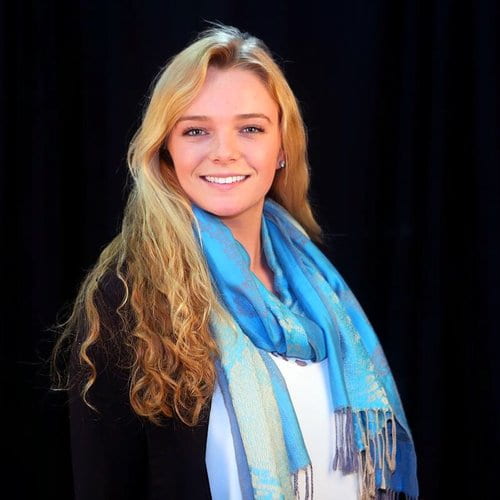Kristen McInerney is one of two Knapp Fellowship winners for the 2018-2019 school year. Community Engaged Scholar Ashley Hidalgo sat down to discuss Kristen's project with her.
Tell me about your project and how you believe/hope that your scholarship will impact the community you are doing research with?
Kristen McInerney (KM): My research project, stems from my experience with English Learners (ELs) who struggled or are struggling in our traditional high school models and I formerly worked at a few different high schools with a growing EL population. My belief is that our current high schools are not set up for English Learners, and that inspired me to apply to this Graduate School of Education and Human Development Doctoral program in Curriculum and Instruction, to see how we can improve the outcomes for ELs. With my research I hope to gather data, that we don’t typically gather upon enrollment of a student, and use it to predict and analyze student outcomes, such as grades and graduation. I am also interested in Resilience Theory and how that relates to my students’ experience in high school. This scholarship will directly impact the immigrant students that I work with and their families and bring the community together. Daily I work with bright, strong, multi-lingual, independent, and inspiring international students who deserve to graduate just like their native English-speaking peers.
AH: That is truly inspiring. What kinds of research methods/methodologies will your research use? I know it was mentioned earlier, but could you elaborate on how these methods bring the community into your work?
KM: My Research Project is my dissertation idea, which is a mixed-methods, explanatory sequential case study, which is beginning with the quantitative data piece to inform qualitative data collection to gain a richer understanding of my students experiences in hopes to tailor programming and policies for English learners. To build community partnerships, I would like to partner with Art Therapists, possibly GW's Art department, to build a mosaic or puzzle mural within our school and share with the wider community. Each student and staff member would create a piece, then it would be combined into a beautiful mosaic, where every single piece is valued and holds an important part in our community. Students will create their design focusing on their identity, the theme of resilience, and what success means for them.
AH: These forms of data collection will be very impactful for students. Why do you think it is important for student researchers (and researchers in general) to incorporate members of the community into research?
KM: Partnerships with the community are incredibly important especially with my population of students as English learners, and really all students. When you think about supporting the whole child and their family, whether they are here or in their home country, it is important to foster a new welcoming home. I think that community partnerships and community participatory action research is really important because the community has a sense of shared ownership, vision, and call to action.
AH: Do you have a favorite researcher/community scholar/activist who inspires you? If so, would you share a quote from them (or a book or article they wrote)?
KM: I have been re-reading the LISA Study by Suarez-Orozco, Suarez-Orozco, and Todorova who did a 5 year longitudinal study of immigrant youth in American high schools. They state in their conclusion, “Immigrant-origin youth come with big dreams and their initial boundless energies and optimism offer a great, if untapped, National resource.” I see that everyday in my students, their energy, their smiles, their excitement, and alongside their tears, and other concerns, and sadness. There is so much potential and strength and assets that our students have, like said if untapped or should be tapped, it is certainly a wealth of knowledge. And to be bilingual or trilingual there are so many things that our students can do and I want to give them the tools and opportunity to do so.
AH: What a great quote! You could have chosen many different ways to do your research-why involve the community? What do you think it adds to the research by doing this?
KM: I believe that my research holds more meaning and it is more empowering when it involves the community. Just like the school that I work in, the staff as a whole has a common passion goal, and drive Also, the more awareness we can draw to a problem, the more potential solutions we can find. And the greater the call to action and greater impact can happen.
AH: Do you anticipate working with any community partners (non-profits, other scholars, students here at GW other students or public institutions (schools, hospitals etc.), in this research?
KM: Yes, I definitely am reaching out to people who are involved with Art Therapy and other forms of social work and dealing with trauma. I know that GW has an Art Therapy program, so I am hoping to build a partnership with them, but I really think that developing partnerships especially for our students will really be able to help us able to reach them and provide the best experience possible in our school.
AH: Is there anything you’d like to say to Former GW President and Mrs. Knapp for funding the Fellowship?
KM: Yes, it is an incredible honor and I would want to first say thank you for believing in my students. They are the reason why we do what we do, and for them to recognize my student population as valuable and worthy, of having one of the best experiences possible in our high schools, that goes a long way trusting and for believing in me. Thank you for seeing ahead, and funding something that is a big passion of mine and for helping me make a difference in my community. It is truly a humbling opportunity and I have a lot of work to do on the project but I would say thank you for believing in me.







